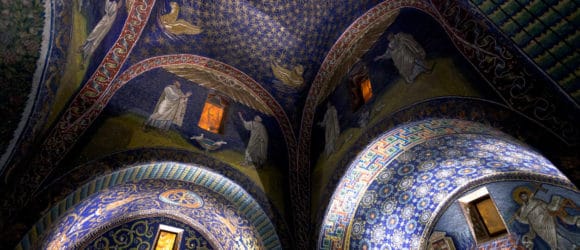Mausoleum of Galla Placidia in Ravenna, Italy

We all know that we will someday die. However, not all of us plan for this eventuality. One mausoleum in Ravenna, Italy – the Mausoleum of Galla Placidia – is a fine example of a beautifully designed final resting place commissioned by its future inhabitant. Let’s learn about the history of this beautiful historic site that was commissioned in the first half of the 5th century.
Galla Placidia and Emperor Constantius III
Galla Placidia was the daughter of Roman Emperor Theodosius the Great, who was the last Emperor to rule the Western and Eastern Roman Empires simultaneously. She received an advanced education. However, her noble origins didn’t protect her from turmoil.
While in Rome, she was kidnapped by Gothic King Alaric as his invaders sacked the city. However, she later married the invader’s King Athaulf. King Athaulf was soon murdered after they married.
Galla Placidia then married Emperor Constantius III. The couple had two children: Justa Grata Honoria and Valentinian III. Constantius III soon died, and her young son, Valentinian, was appointed Caesar.
Galla Placidia found herself regent of the Western Roman Empire for her young son – Emperor Valentinian III. As regent, Galla Placidia headed many building projects in Rome, Jerusalem, and Ravenna. One of those building projects was her own mausoleum.
Galla Placidia Mausoleum
When you look at the exterior of the Mausoleum of Galla Placidia, you will see a small, unadorned brick building. It stands in the garden of the Basilica di San Vitale in Ravenna. However, upon entering the mausoleum, which is about a century older than the Basilica, you will see the upper walls, arches, dome, and ceiling covered entirely in a beautiful mosaic.
At the center of a dome is a starry sky. Christian symbols and figures make up the rest of the design. Visitors will see a golden Latin cross, Christ the Good Shepherd surrounded by sheep, mosaics of eight apostles, and St. Lawrence with a gridiron – the symbol of his martyrdom.
While art history majors would undoubtedly appreciate seeing some of the best surviving examples of this form of art in Europe, one shouldn’t forget about the original intent of the building. However, although the interior of the mausoleum has the softly lit peacefulness and beauty of a final resting place, the three sarcophagi are empty.
History records that Galla Placidia died in Rome in 450. She is most likely buried in Rome. Even though she planned that the structure would be used as a mausoleum, it acted as an oratory or chapel for St Lawrence.
Key Takeaways
Although Galla Placidia was of noble birth, she overcame many hardships throughout her life.
While serving as regent for her son, Galla Placidia commissioned many significant buildings – including her own mausoleum.
Although Galla Placidia’s body was never placed in her mausoleum, the beautiful space continues to awe and inspire visitors today.
What Can We Learn From Galla Placidia and the Western Roman Empire?
Among all the lessons we can learn from Galla Placidia, perhaps the most important is the necessity of planning for our future – even if it is unpredictable.
When you are ready to make decisions about your final resting place, request a consultation with Eternal Mausoleums by Forever Legacy. We will help you create a beautiful private resting place for your entire family – a peaceful place that your progeny will visit for generations to come.
Belinda McLeod has a degree in Secondary Education, specializing in English and Journalism. She began her career as a freelance writer in 2018 since a flexible schedule would allow her to help care for an aging parent. Since then, Belinda has specialized in writing for the funeral industry. Belinda has written for Cake, a funeral-planning website, nursing homes, mausoleum companies, cremation companies, and funeral homes.
